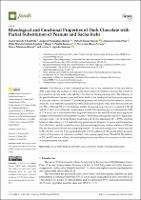| dc.contributor.author | Quispe Chambilla, Lucero | es_PE |
| dc.contributor.author | Pumacahua Ramos, Augusto | es_PE |
| dc.contributor.author | Choque Quispe, David | es_PE |
| dc.contributor.author | Curro Pérez, Francisco | es_PE |
| dc.contributor.author | Carrión Sánchez, Hilka Mariela | es_PE |
| dc.contributor.author | Peralta Guevara, Diego E. | es_PE |
| dc.contributor.author | Palomino Rincón, Henry | es_PE |
| dc.contributor.author | Masco Arriola, Mery Luz | es_PE |
| dc.contributor.author | Ligarda Samanez, Carlos A. | es_PE |
| dc.date.accessioned | 2023-04-20T16:27:14Z | |
| dc.date.available | 2023-04-20T16:27:14Z | |
| dc.date.issued | 2022 | |
| dc.identifier.uri | https://hdl.handle.net/20.500.14168/770 | |
| dc.description.abstract | Chocolate is a widely consumed product, due to the contribution of fats and antioxidant
compounds; the addition of other components makes it possible to increase the content of
polyunsaturated fatty acids, although they can affect its rheological properties. The influence of
the partial addition of peanut paste and Sacha Inchi on the rheological and functional properties
of dark chocolate was evaluated. Cocoa beans, peanuts, and Sacha Inchi were refined in order to
obtain the cocoa paste (PC), peanut paste (PM), and Sacha Inchi paste (PSI). Then, mixtures between
0 to 20% of PM and PSI were formulated, and the rheological properties were evaluated at 30, 40,
and 50 C; these were adjusted to mathematical models. Functional groups were identified by FTIR
in ATR mode, and it was observed that the partial addition of PM and PSI did not show significant
changes in the shear stress and apparent viscosity of the mixture, although they did show dependence
on temperature. The Herschel–Bulkley model showed a better adjustment (R2 > 0.999), reporting
behavior index values, n < 1.0, and indicating pseudo-plastic behavior for pastes and formulations.
The yield limit ty and the consistency index kH increased significantly with the addition of PM and
PSI, but they decreased with increasing temperature. The activation energy show values between
13.98 to 18.74 kJ/mol, and it increased significantly with the addition of PM and PSI. Infrared analysis
evidenced the presence of polyunsaturated fatty acids, coming mainly from PSI and PM. The addition
of PM and PSI does not influence the rheological properties and allows for an increase in the content
of polyunsaturated fatty acids. | es_PE |
| dc.format | application/pdf | es_PE |
| dc.language.iso | eng | es_PE |
| dc.publisher | Licensee MDPI, Basel, Switzerland. | es_PE |
| dc.rights | info:eu-repo/semantics/openAccess | es_PE |
| dc.rights.uri | | es_PE |
| dc.rights.uri | http://creativecommons.org/licenses/by-nc-nd/4.0/ | * |
| dc.subject | cocoa; Sacha Inchi; peanut; fatty acids; activation energy; rheological properties | es_PE |
| dc.title | Rheological and functional properties of dark chocolate with partial substitution of peanuts and sacha inchi | es_PE |
| dc.type | info:eu-repo/semantics/article | es_PE |
| dc.type.version | info:eu-repo/semantics/publishedVersion | es_PE |
| dc.publisher.country | CH | es_PE |
| dc.subject.ocde | http://purl.org/pe-repo/ocde/ford#2.11.01 | es_PE |
| dc.identifier.doi | https://doi.org/10.3390/ foods11081142 | es_PE |


